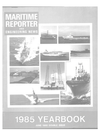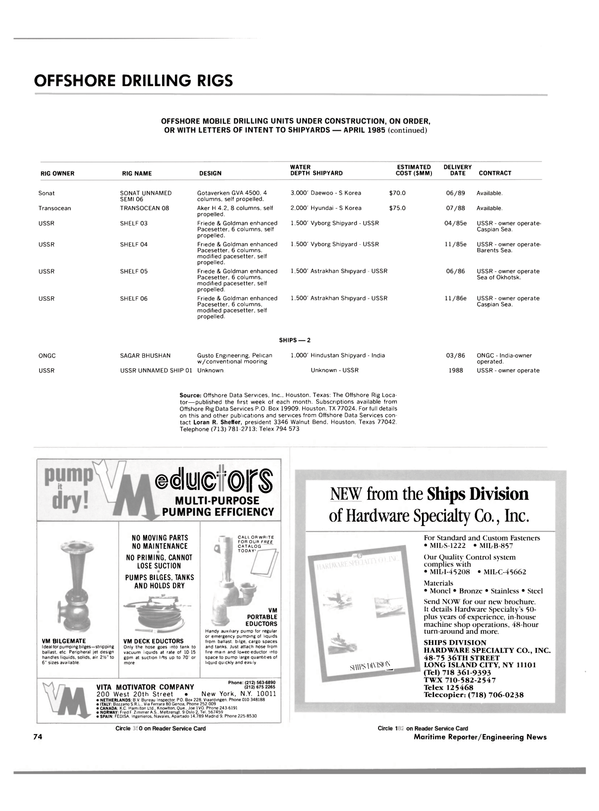
CANADIAN SHIPBUILDING — 1985 —
REVIEW AND OUTLOOK The data in this annual statistical report brings home hard the fact that the Canadian shipbuilding, ship repairing and allied industries are at the crossroads. Policies must be implemented to strengthen our industry.
A new federal government was elected last September that promised changes in policy to revitalize the shipbuilding, ship repairing and allied industries. The Progressive Conservative Atlantic caucus said on August 2: "A top priority of a P.C. government will be to create a more viable and prosperous shipbuilding industry." But no changes in policy have been brought forward to date, although shipbuilders have constantly warned of the fragile state of the industry.
A joint Government/Industry meeting held on Parliament Hill January 23, 1985 unanimously endorsed resolutions to strengthen the industry. We are confident that implementation of these proposals will result in the revitalization of the industry and employment, including the generating effect, for over 42,000 Canadians.
Canada has historically been a nation of ships and shipbuilders.
Canadian shipyards have remained remarkably resilient during the worldwide shipbuilding crisis, through the late '70's and early '80's.
But last year saw the failure of two Nova Scotia yards. One was taken over by new management from ULS International Inc. while the provincial government is currently negotiating for a new buyer for Halifax Industries.
Because of the major government ship procurements during the year, Allied Industries marine production increased 1.5 percent. The CSSRA had a record 71 Allied members at the end of 1984. Many of our allied industries depend on healthy ship order books and their future is closely tied to the shipbuilding industry.
Last year the CSSRA submitted a brief to the Task Force on Deep-Sea Shipping, a follow-up brief to the Royal Commission on the Economic Union and Development Prospects for Canada, a personal brief to new Regional Industrial Expansion Minister Sinclair Stevens in October and a brief on the temporary entry situation was released in December.
Another brief was presented at the joint Government/Industry meeting in January, 1985. All our briefs and comments were well received, but we have seen virtually no action on our recommendations.
The Canadian shipbuilding and allied industries are capable of filling domestic requirements. Many yards have upgraded facilities and with the cooperation of their unions have adopted realistic labour practices to meet this challenge.
Production Summary CSSRA shipyards, which account for 95 percent of all vessels built in Canada 100 gross tonnage or more, had 32 vessels of 151,700 GT under construction or on order at December 31, 1984. Of these, 21 vessels, or 59,400 GT, were orders for the federal government. Federal government orders represented 39.2 percent of all new tonnage under construction or on order at the end of 1984. New government orders during 1984 included two type 800 navaids, two type " F " navaids, one type 1200 medium icebreaker, all for the Coast Guard, and one acoustic sweep vessel for Fisheries and Oceans. There was an increase of six units under construction or on order compared to the end of 1983, but an 11.3 percent decrease in tonnage levels. There was a total of 15 new orders in 1984, lower than the 23 recorded last year, but up from eleven ordered in 1982.
Member yards delivered eight vessels of 51,800 GT in 1984, including the M.V. "Prairie Harvest", a Great Lakes self unloader, and the "Bow Drill 3", a semi-submersible drilling rig. This compares with 17 deliveries of 112,300 GT in 1983 and 39 deliveries of 115,400 GT in 1982.
The only export delivery in 1984 was the "Bow Drill 3".
Dollar value of new construction by member yards totalled $288,204,000 during 1984, a drop of 24.5 percent compared to 1983's level of $381,743,000. New construction for export totalled $36,046,000, down 68.8 percent from $115,628,000 in 1983. Of the 1984 total, $36,000,000 was for the "Bow Drill 3".
Repairs and conversions increased 22.8 percent to $250,685,000 from $204,222,000 in 1983. Federal government repairs and conversions amounted to $87,426,000, a 49.6 percent increase over 1983 levels.
Total dollar value of new construction and repairs and conversions slipped to $538,889,000, an eight percent drop from 1983's level of $585,965,000. The estimated value of CSSRA Allied Industries marine production was up 1.5 percent to $155,875,000. Total CSSRA member production declined six percent from $739,465,000 to $694,764,000.
Prices of most materials used by the shipbuilding and ship repair industry showed increases from 1983 to 1984, with the exception of wood products, copper and paints and varnishes, which decreased 5.1, 10.4 and 0.2 percent, respectively.
The world order book registered a decline in number of vessels and tonnage under construction or on order at the end of 1984 in comparison with 1983 levels. A total of 2,467 vessels, or 30,688,000 GT, were under construction or on order at the end of 1984, compared with 2,774 vessels of 32,620,000 GT at the end of 1983. Canada completed five merchant vessels totalling 26,000 GT last year, or 0.1 percent of the world total. Canada had 18 merchant vessels, or 0.4 percent of the world total, under construction or on order at December 31, 1984. At the end of 1983, Canada had 17 vessels and 0.3 percent of the total world order book.
Read CANADIAN SHIPBUILDING — 1985 — in Pdf, Flash or Html5 edition of June 1985 Maritime Reporter
Other stories from June 1985 issue
Content
- McDermott Gets Contract From SOHIO To Build Offshore Drilling Platform page: 6
- Shipboard Safety Criteria Monitored By Siemens Computer page: 6
- Puroflow Gets Canadian Order For Ultraviolet Water Purification Systems page: 6
- Moss Point Marine To Build Victorian-Style Sternwheel Riverboat page: 7
- Fiberglass Passenger Vessel Built By Westport For Catalina Channel page: 8
- New Facility Opened By Lips Propellers At Todd-Seattle Shipyard page: 9
- Samson Offers Brochure On Passive Mooring Systems For Supply Vessels page: 9
- Marathon LeTourneau To Construct World's Largest Bottom Supported Mobile Offshore Drilling Unit page: 12
- GEC Rolls-Royce Gensets Selected For Shell/Esso Tern Offshore Platform page: 14
- A S S C O Elects B a u m l e r V P - M a r k e t i ng page: 15
- N e w B r o c h u r e F r om W e s t i n g h o u s e Discusses C o m b u s t i o n T r i m C o n t r ol page: 15
- Raytheon Introduces JRC Color And Digital Rasterscan Radar Unit page: 16
- Simpson Timber Restructuring Its Panel Products Division page: 16
- Ingersoll-Rand Signs Sales Agreement With Kawasaki page: 17
- Murray Grainger Resumes Business Activities As Used Equipment Dealer page: 20
- New Remote Control VHF Marine Radio Introduced By Uniden page: 20
- Mitsubishi Introduces Latest Diesel Engine At New York Seminar page: 21
- Contract For Wharf At Cow Head Oil Rig Servicing Facility Awarded page: 22
- Marathon LeTourneau Exhibits Slo-Rol® Motion Suppression Technology During 1985 OTC page: 23
- Aluminum Boats Delivers Whale Watch Excursion Boat page: 23
- I.T.C. Holland Engineers Its Third Double Rig Dry Transport On The Sibig Venture page: 25
- Hitachi Zosen Completes Two Power Generating Barges For Philippines page: 25
- FUTURE U.S. NAVY BUSINESS OPPORTUNITIES —A $230 billion # 5 Year Market— page: 26
- US SHIPBUILDING OUTLOOK Markets & Cost Saving page: 44
- Secretary Dole Promulgates CDS Repayment Rule page: 44
- U.S. MARITIME ASSETS AND NATIONAL SECURITY page: 48
- THE CIRCLE OF RELIANCE " I n Time of War, Land, Sea, and Air Forces and All Logistic Support Functions Must Work as a Team" page: 50
- THE GOVERNMENT AS PARENT TO INDUSTRY: PARTICIPATION OR BENIGN NEGLECT? page: 52
- A SUCCESSFUL MARITIME POLICY UNDER ATTACK page: 58
- Offshore Service Vessels, Tugboat And Inland Towboat Fleets page: 60
- U.S. COULD LEARN A LESSON FROM GREAT BRITAIN'S OFFSHORE OIL LEASING page: 65
- CANADIAN SHIPBUILDING — 1985 — page: 76
- Liu Elected Vice President Of American Bureau To Head R&D Division page: 79
- VTHE NEW DDG-51 CLASS GUIDED MISSILE DESTROYERS —A Report— page: 80
- Harris Gets Subcontract To Supply HF Equipment For Canadian Frigate Program page: 89
- Brochure On "Sea Float" Marine Buoys And Floats Offered By Seaward page: 89
- Multi-Purpose Freighters To Be Built By Seebeck page: 89
- Omnipure Awarded $1.3-Million Contract From Canadian Navy page: 90
- New IMA Report On Future U.S. Navy Procurement Now Available page: 90
- Dubai Drydocks Reports Profit For Second Year page: 91
- Farboil Offers Free Four-Color Folder On Wetsall® Coatings page: 91
- Devoe Offers Brochure On Marine And Corrosion Control Paints & Coatings page: 92
- New Portable Hoists Line With Failsafe Brakes Now Available From PHD page: 92
- World Transport Coordinates Wet Tow Of Western Oceanic Rig page: 93
- Marinette Marine Installs First DWB Ship Transfer System In North America page: 93
- Norcontrol Offers Brochures On Navigation/Instrumentation Line Marketed In U.S. By Nav-Control page: 94
- Nichols Brothers Builds New McNeil Island Ferry page: 97
- Rowan Offers Free Literature On Drill Rig 'Rowan Gorilla IV' page: 97
- Raytheon Introduces Newest SatCom For Fishing And Pleasure Craft page: 98
- Crawford Fitting Introduces Gap Inspection Gages For SWAGELOK Tube Fittings page: 98
- Jeffboat Delivers Deck Barge For Nugent Sand Company page: 99
- Unique Actuator Selection Slide Chart Available From Jamesbury Corp. page: 99
- CRUISE '85 SHIPS • OPERATIONS • SERVICES page: 100
- Aeroquip T-J Division Offers New Series TP Proximity Switches page: 101
- Valcor Catalog Includes Products For Marine And Naval Applications page: 102
- Apelco Introduces Loudhailer With Two-Way Intercom And Alarm Features page: 102
- Marine Management Develops Demo Programs page: 103
- Marco-Seattle Converts Two Combination Crabbers For New Fishery Roles page: 103
- Markey Supplies Tug With Two Capstans page: 104
- Southwest Marine Yard Repowering San Francisco Commuter Ferries With Detroit Diesel Allison Engines page: 104
- AMETEK Announces Computerized Inspection Management System page: 105
- "Marine Library" Literature Available From DDA page: 105
- Furuno Introduces FR-803D Digital Radar page: 105
- MariChem 85 page: 106
- LIQUID CARGO HANDLING EQUIPMENT —A Review— page: 108
- Marathon LeTourneau GranGulf™ Semi Design Offers Economic Construction & Optimum Deck Load page: 113
- First Interactive Shiphandling Simulators From Ship Analytics Being Commissioned page: 116
- Stewart & Stevenson 'Mean 16' Provides Patrol Boats With New Power And Cruising Range page: 119
- Literature Available On Navlink From Datamarine page: 119
- Elliott White Gill Names New Sales Agent For Taiwan page: 120
- Blackinton Named General Manager Of Bethlehem-Beaumont Yard page: 120
- DAMPA Continuous Ceiling Approved By U.S. Navy— page: 121
- Ingersoll-Rand Forms New Compressors Division page: 122
- Menge Named Agent For Seaward Fenders page: 122
- Lanzendorfer Will Manage Fairbanks Morse Service Facility in San Diego page: 124
- $5.3-Million Navy Program Received By Tracor page: 124
- Gensler Named Director Of Marketing And Sales For InterTrade Industries page: 124
- WABCO Offers 8-page Brochure On Logicmaster™ Marine Propulsion Control Systems page: 133
- Free 12-Page Color Brochure Availale From Falk On New Shaft Speed Reducer Line page: 133


